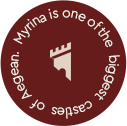Buildings


The Buildings
There is little information on the nature and the time of construction of several buildings on the castle site. During the period of the Ottoman rule, a settlement had developed inside the kastro, the architectural remains of which include houses, a cemetery, a mosque, a gunpowder store, a barrack for the garrison and a refuge.
Mosque
(Building B)
It is located to the left of the path and opposite the Barrack (Building C). The mosque is identified by the miḥrāb, and the traces of a staircase leading up to the gallery, which was used exclusively by women.

Barrack
(Building G)
During the Ottoman period a settlement developed in the interior of the kastro. The architectural remains of this settlement include also a barracks for the garrison. Housed here were the Mutesarrif and the Subaşi, the civil governor and the military commander of Lemnos, respectively, as well as some officers, dignitaries and administrative officials with their families.

Gunpowder
(Building H)
Located here is the gunpowder store of the Ottoman period. Thid building of robust construction was used for safekeeping the ammunition and has a protective enclosure. A similar one exists in the castle of Rethymno.

Refuge
(Building L)
This underground building consists of three vaulted-roof spaces. According to existing indications, one space seems to have been used in the past as a cistern for collecting rainwater. The other two spaces were perhaps used as cellars for foodstuffs or even as a refuge in the event of danger.
The remains intra muros include additionally 7 wells and 3 stone-built cisterns (1 north near the fortification wall, 1 to the southwest, 1 east near the inner north wall) which supplied water to the inhabitants and the defenders of the kastro, and which are of uncertain date (according to researchers they are perhaps of the Late Roman or Early Byzantine period). In the northwest corner of the upper terrace stands an intact building of robust construction with protective enclosure, which was used as a gunpowder store during the period of the Ottoman rule.
Particularly impressive is the monumental building at a considerably lower point, to the north of the main entrance and close to the east fortification walls. Distinguished by its careful construction, it has a pitched stone roof, 2 buttresses at each corner and an entrance on the east side. It is noteworthy that in the castle rampart opposite the entrance to the building there is a large blind apse. The building and the apse appear to be parts of a complex of indeterminate function. It is suspected that this is the mausoleum of Caterina Gattiluso, wife of the last emperor of Byzantium Constantine XI Palaiologos, who was buried inside the kastro. There are indications that it was used also as a gunpowder store.
Last, remains of twentieth-century constructions include 1 tunnel and passages for storing munitions, as well as very few architectural remnants of sentry posts and small buildings, which were put up during the Second World War (1941-1944) by the German Occupation forces.









